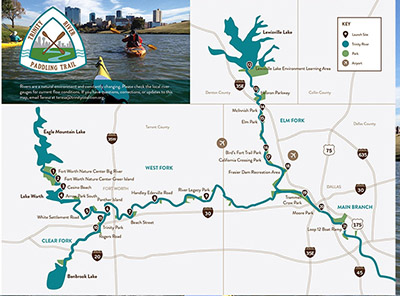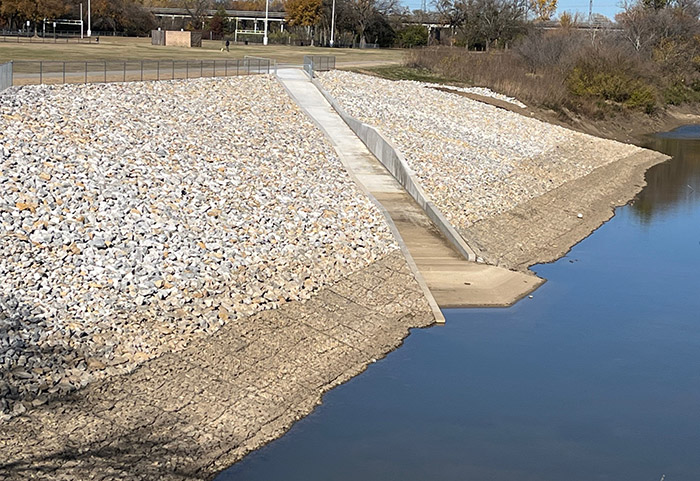Trinity River paddling trail plans to add more North Texas canoe launch sites
Almost two dozen canoe and kayak launch sites dot 130 miles of riverbank along the Trinity. After a year of planning, one group has set long-term goals for integrating all 21 launch sites into a single paddling trail.
The nonprofit Trinity Coalition’s ambitions were rewarded in October 2020, when the Upper Trinity River Corridor became one of 33 U.S. rivers — and the only in Texas — to be designated as a National Water Trail by the National Park Service. Beyond supporting tourism to the river, the designation helps build community behind ecosystem restoration and water health, according to the park service.
This spurred the project’s supporters into action. In 2021, a task force consisting of representatives of the Trinity Coalition and the North Central Texas Council of Governments was formed to develop a master plan to determine the trail’s future funding needs and expansion plans. Nearly three years later, a master plan has been developed, with recommendations and action items for the Trinity Coalition to start implementing.
“It’s really meant to be kind of a recommendation and a final report,” said Erin Blackman, a senior planner for the council of governments. “It’s to help identify some long-range actions and provide some resources for the communities and Trinity Coalition to maintain and further the water trail.”
The master plan includes eight goals Trinity Coalition should strive to achieve. These include development, promotion, access, maintenance, protection, integration, prosperity and legacy.
According to the master plan, Trinity Coalition should aim to develop new launch sites to reduce distance between sites and provide more communities and residents with access to the water trail.
While the National Park Service does not set a maximum distance between launch sites, a comfortable distance for recreational paddlers is approximately 7 miles or less, according to the master plan. Although most launch sites on the Trinity River are 7 miles apart, there are a few that aren’t. For example, the distance between Arlington’s River Legacy Park and Dallas’ Trammell Crow Park launch sites is 24 miles.
Canoe launches are installed by cities, not the Trinity Coalition or the council of governments, said Steve Smith, board chair of the Trinity Coalition.
“But the cities are closely connected and a member of the council of governments,” he said. “So when they have a canoe launch plan, they will let (the council of governments) know about it and then we will find out about it. The most recent example is that Irving is putting in a really spectacular canoe lodge at their Trinity View Park, and they’re well into the construction of that.”
Trinity Coalition plans on promoting the river to encourage communities to actively engage with it — whether recreationally or learning about its historical and cultural significance.
 Volunteers with Keep Fort Worth Beautiful use kayaks to clean trash out of the Trinity River March 25, 2023 at the river near Merrimac Circle during the Cowtown Great American Cleanup. (Cristian ArguetaSoto | Fort Worth Report)
Volunteers with Keep Fort Worth Beautiful use kayaks to clean trash out of the Trinity River March 25, 2023 at the river near Merrimac Circle during the Cowtown Great American Cleanup. (Cristian ArguetaSoto | Fort Worth Report)
Regional officials are excited about the project, said Susan Alvarez, director for the environment and development department in the council of governments. The paddle trail makes the river “a fun and magical place to go, rather than just where you dump your wastewater or stuff from the Stockyards,” she said.
“The river itself has had an amazing turnaround from its early days of being basically an open sewer,” Alvarez said. “I think that the one thing that’s been really critical is changing how people view the river and changing their relationship with the river.”
Smith said the Trinity Coalition has begun its campaign through its website, where the coalition promotes the use of the river, safety tips for the water trail and the beauty of the river. The coalition also holds events where the community can do paddle trips, he said.
To change people’s views on the river, ongoing maintenance needs to be routinely done to ensure cleanliness and safety of the water trail, said Jai-W Hayes-Jackson, who coordinated the master plan for the council of governments.
The master plan recommends installing cohesive signage throughout the trail that clearly marks hazardous areas, ensuring the launch sites are accessible for anyone with diverse abilities and backgrounds, and establishing a routine inspection schedule of all launch sites.
“Trinity River isn’t always seen as the cleanest river to partake in,” Hayes-Jackson said. “A lot of feedback we got was making sure that we’re promoting stewardship habits, as well as just promoting that the quality of the river is safe to actually traverse within.”
Another way to change the views on the Trinity River is highlighting its cultural and historical significance. The master plan recommends the Trinity Coalition collaborate with local historians, community leaders and Indigenous populations to collect oral histories, photographs and personal accounts related to the river.
 Volunteers with Keep Fort Worth Beautiful take a kayak back up a hill March 25 at the Clear Fork Trinity River near Merrimac Circle during the Cowtown Great American Cleanup. (Cristian ArguetaSoto | Fort Worth Report)
Volunteers with Keep Fort Worth Beautiful take a kayak back up a hill March 25 at the Clear Fork Trinity River near Merrimac Circle during the Cowtown Great American Cleanup. (Cristian ArguetaSoto | Fort Worth Report)
The partnership between the council of governments and Trinity Coalition has come to a close, and Smith said he’s grateful for the resources the council provided. Now, the Trinity Coalition is looking for funding to help start implementing the master plan.
“Now that we have the master plan, we’ve got plenty of ammunition to install that master plan,” Smith said. “For the plan to get implemented, we need businesses, individuals and philanthropists to understand that we’ve got an amazing plan and we need funding.”
Smith said he hopes the paddling trail will attract tourists and North Texas community members to see why it’s important to maintain these waters. In the future, he envisions the paddling trail connecting all the way down to Galveston’s coast.
“Unless the river is worth getting out on, you’re not going to do it,” Smith said. “Clean it up, get people out there, promote it, get people access to kayaks and eventually have significant economic activity like they have in Austin.”
Kevin Vu is a recent graduate of the University of Texas at Austin and contributor to the Fort Worth Report.
This article first appeared on Fort Worth Report and is republished here under a Creative Commons license.![]()




